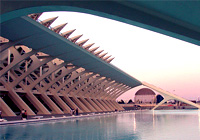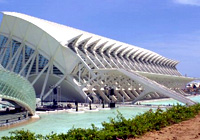La Ciudad de las Artes y las Ciencias
This incredible collection of buildings houses some of the world's most cutting edge science and art exhibits and showcases Santiago Calatrava's exceptional ability to express what is inside a building through its exterior design. Calatrava chose to include an abundance of water in his design to complete his full vision for each building and add a magical touch to the futuristic style of the whole place. The visitor not only admires the building itself, but its reflection in the water below is what completes the full picture.The late Felix Candela also contributed to the design with his L'Oceanografic - Europe's biggest aquarium and a paradise for all those fans of life under the sea.
The Ciudad de las Artes y las Ciencias was a project to bring in more tourism to Valencia outside the influx that come to enjoy Las Fallas in March. Built between 1991 and 2006, the City of Arts and Sciences has been expanded bit by bit to make it what it is today.


Calatrava was presented with the challenge of designing a planetarium, opera house and science museum on the old bed of the River Turia. After a flood destroyed the area in 1957 the river was diverted leaving a redundant area of land stretching 10km across the city centre. The government decided to make use of the land and so comissioned the building of the Ciudad de las Artes y las Ciencias which has fast become the second most visited tourist attraction in the whole of Spain.
The first building to be opened was L'Hemisfèric (Planetarium) in 1998. The Planetarium also houses the IMAX cinema and is the most iconic of the whole Ciudad de las Artes y las Ciencias. Calatrava drew his inspiration for the building from an eye which serves as a universal 'eye opener' to all who enter it and learn from what is found within. The enormous dome which houses the planetarium and IMAX cinema is flanked by aluminium rods which structurally serve to support the building but which appear aesthetically as the eye socket. Calatrava's construction only gives half the picture - the reflections in the man-made ponds which surround the building serve to complete the full shape of the eye. Inside L'Hemisfèric the highest technology is used for all sorts of IMAX, Planetarium and laser shows.
Two years after the opening of L'Hemisfèric, Calatrava's second futuristic construction opened its doors to the public. Museo de las Ciencias Príncipe Felipe is an enormous science museum with lots of hands on exhibits. The three story building is made up of a series of levels and bars which hint at the formation of an animal's backbone.
In 2001 L'Umbracle or 'Parking Structure' was opened. Without a doubt, this is the most attractive car park you will ever see. With space for over 900 vehicles, Calatrava has cleverly used the space practically whilst also ensuring it is a pleasant and usable area. Above the car park is an enormous promenade sheltered by metal arches and lined with trees. It makes a tranquil spot to take a stroll and is the perfect place to enjoy views overthe entire Ciudad de las Artes y las Ciencias.
Calatrava's final addition to the Ciudad de las Artes y las Ciencias is the spectacular Palacio de las Artes Reina Sofia (the Reina Sofia Opera House). Containing four different auditoriums, the 'Palacio' has seen many important musicians play within its walls. The vast edifice is like an enormous piece of modern sculpture along the skyline, but it also serves very functional purposes. Made from a combination of white concrete and Gaudiesque broken tiles, the roof is made from an enormous feather shaped plume, which gives an extremely elegant feel (as one would associate with the opera).
Valencia's Ciudad de las Artes y las Ciencias is a real tribute to modern architecture and makes for an unforgettable day out.


